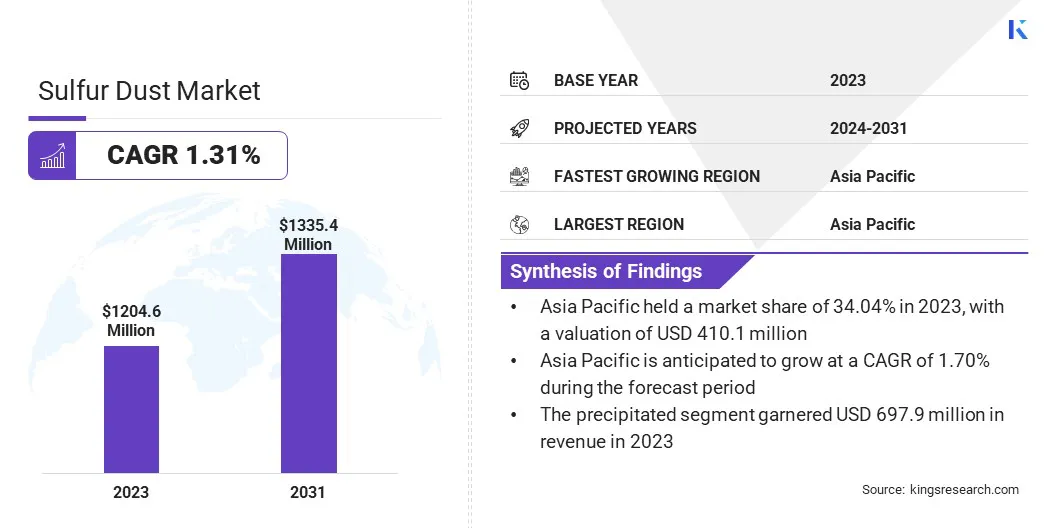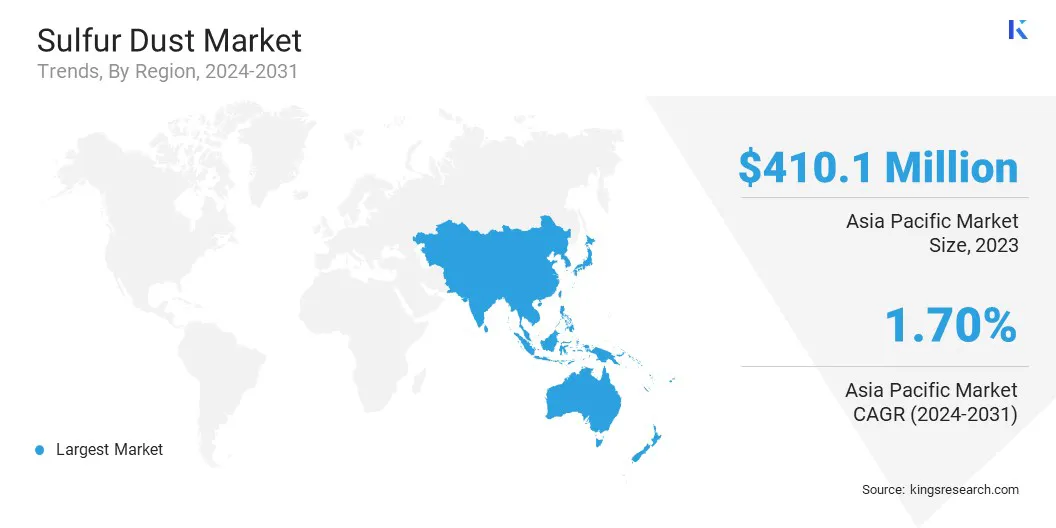Market Definition
The market encompasses the trade and distribution of finely ground sulfur particles, typically used in agricultural applications as a fungicide and pesticide.
It is also utilized in industrial processes, such as the production of sulfuric acid and other sulfur-based chemicals. The market involves various suppliers, manufacturers, and users across different regions and industries.
Sulfur Dust Market Overview
Global sulfur dust market size was USD 1204.6 million in 2023, which is estimated to be valued at USD 1219.3 million in 2024 and reach USD 1335.4 million by 2031, growing at a CAGR of 1.31% from 2024 to 2031.
Sulfur dust's use in controlling pests and improving soil health promotes sustainable farming practices. Its natural, non-toxic properties make it an attractive option for eco-friendly agricultural solutions, driving market growth.
Major companies operating in the sulfur dust market are BASF SE, Jaishil Sulphur & Chemical Industries, Jordan Sulphur, Solar Chemferts Pvt Ltd, MARUTI CORPORATION, Anmol Chemicals Private Limited, Central Drug House, Grupa Azoty, Jainson Chemicals, JS TECHNOLOGY PVT, Kaycee Chem Industries, Mahaveer Surfactants Private Limited, Merck KGaA, M. K. CHEMICAL INDUSTRIES, NANOCHEMAZONE, and others.
The market is characterized by its widespread use in agriculture, industry, and chemical production. Its serves as a key a fungicide and pesticide, enhancing crop protection and productivity.
The market also sees significant demand from industries such as metal refining and sulfuric acid production. As a versatile and cost-effective product, sulfur dust remains integral to global trade and industrial processes.

Key Highlights:
- The sulfur dust industry size was recorded at USD 1204.6 million in 2023.
- The market is projected to grow at a CAGR of 1.31% from 2024 to 2031.
- Asia Pacific held a share of 34.04% in 2023, with a valuation of USD 410.1 million.
- The precipitated segment garnered USD 6 million in revenue in 2023.
- The pesticides & fungicides segment is expected to reach USD 326.6 million by 2031.
- Europe is anticipated to grow at a CAGR of 1.33% over the forecast period.
Market Driver
"Increased demand for Agricultural Products"
Increased demand for agricultural products is fueling the growth of the sulfur dust market, given its vital role in crop protection. Widely used as a natural fungicide and pesticide, particularly in organic farming, sulfur dust offers an alternatives to synthetic chemicals.
As global food production rises to meet growing population needs, farmers are turning to sulfur dust to safeguard crops against diseases and pests, supporting market expansion and sustainable agricultural.
- As per a June 2023 Press Information Bureau (PIB) article, the introduction of Sulphur-coated Urea (Urea Gold) aims to address sulfur deficiencies in soil while reducing input costs for farmers. This initiative ia projected to enhance soil productivity and promote sustainable farming practices.
Market Challenge
"Supply Chain Disruptions"
Supply chain disruptions caused by natural disasters, geopolitical instability, or logistical bottlenecks present a significant challenge to the development of sulfur dust market, impacting production, causing price volatility, and leading to supply shortages. These disruptions can hinder the timely delivery of raw materials and finished products, straining the market.
To mitigate these risks, companies are diversifying their sourcing strategies, investing in more resilient logistics networks, and adopting real-time supply chain monitoring technologies for greater resilience.
Market Trend
"Ongoing Technological Advancements"
The sulfur dust market is witnessing significant technological advancements aimed at improving production, storage, and handling processes. Innovations such as automated sulfur handling systems, advanced dust collection technologies, and more efficient sulfur extraction methods are being adopted to enhance safety and operational efficiency.
These technologies minimize risks associated with sulfur dust exposure while optimizing production processes, reducing waste, and improving cost-effectiveness. This is prompting businessesto integrate these advancements to meet regulatory standards and enhance profitability.
- In December 2023, Sulvaris advanced agricultural technology with Micronized Sulfur Technology (MST), improving sulfur availability in soils. MST optimizes crop sulfur uptake, reduces leaching, and ensures residual sulfur for subsequent crop, boosting yields and maximizing ROI.
Sulfur Dust Market Report Snapshot
|
Segmentation
|
Details
|
|
By Form
|
Sublimed, Precipitated
|
|
By Application
|
Pesticides & Fungicides, Fertilizers & Soil Amendments, Chemical Intermediates, Rubber Processing, Pharmaceuticals, Metal Processing, Others
|
|
By Region
|
North America: U.S., Canada, Mexico
|
|
Europe: France, UK, Spain, Germany, Italy, Russia, Rest of Europe
|
|
Asia-Pacific: China, Japan, India, Australia, ASEAN, South Korea, Rest of Asia-Pacific
|
|
Middle East & Africa: Turkey, UAE, Saudi Arabia, South Africa, Rest of Middle East & Africa
|
|
South America: Brazil, Argentina, Rest of South America
|
Market Segmentation
- By Form (Sublimed and Precipitated): The precipitated segment earned USD 697.6 million in 2023, mainly due to its superior efficiency in agricultural applications, enhancing crop protection and soil health.
- By Application (Pesticides & Fungicides, Fertilizers & Soil Amendments, Chemical Intermediates, Rubber Processing, Pharmaceuticals, Metal Processing, and Others): The pesticides & fungicides held a share of 24.45% in 2023, attributed to rising agricultural demand for effective, eco-friendly sulfur-based pest control solutions..
Sulfur Dust Market Regional Analysis
Based on region, the global market has been classified into North America, Europe, Asia Pacific, Middle East & Africa, and Latin America.

Asia Pacific sulfur dust market accounted for a share of around 34.04% in 2023, wvalued at USD 410.1 million. This is primarily due to the region's significant agricultural activities, where sulfur dust is widely used for crop protection and soil enhancement.
Additionally, the strong industrial growth in countries such as China and India, coupled with increasing investments in infrastructure and manufacturing, boosts the demand for sulfur dust in various applications, including rubber processing, metal extraction, and fertilizers.
- As per the Asian Development Bank, over 2.2 billion people in Asia rely on agriculture, creating significant demand for sulfur dust. Its use in pesticides, fungicides, and soil amendments is vital for improving crop protection and ensuring food security in the region.
Europe sulfur dust industry is set to grow at a CAGR of 1.33% over the forecast period. The increasing adoption of sustainable agricultural practices, stringent environmental regulations, and the growing demand for organic fertilizers are stimulating this growth.
Countries such as Germany, France, and the UK are investing in innovative sulfur dust production technologies and expanding their product portfolios.Europe's focus on eco-friendly farming solutions and industrial advancements positions the region for rapid expansion in the coming years.
Regulatory Frameworks
- In the U.S., the Environmental Protection Agency (EPA) regulates and enforces policies to safeguard public health and the environment while conducting research.
- In the EU, the Registration, Evaluation, Authorisation and Restriction of Chemicals (REACH) regulation, mitigates chemical-related risks to human health and the environment while enhancing the competitiveness of the EU chemicals industry.
Competitive Landscape
Companies operating in the sulfur dust industry are implementing several strategies to expand their presence. Strategic partnerships are allowing companies to tap into new regions and industries. By joining forces, firms can enhance production capabilities, access broader customer bases, and meet the rising demand for sulfur dust in agriculture, chemicals, and industrial applications.
These collaborations enable businesses to leverage shared expertise and resources, supporting growth, enhancing market penetration, and ensuring competitive advantage in both established and emerging markets.
- In November 2024, Saeed Ghodran Group and Tanajin Group formed a strategic partnership to expand the National Company for Agricultural and Industrial Sulphur’s presence in China. The agreement aims to increase exports to one million tons by 2026, promoting innovative, sustainable agricultural sulfur products.
List of Key Companies in Sulfur Dust Market:
- BASF SE
- Jaishil Sulphur & Chemical Industries
- Jordan Sulphur
- Solar Chemferts Pvt Ltd
- MARUTI CORPORATION
- Anmol Chemicals Private Limited
- Central Drug House
- Grupa Azoty
- Jainson Chemicals
- JS TECHNOLOGY PVT
- Kaycee Chem Industries
- Mahaveer Surfactants Private Limited
- Merck KGaA
- K. CHEMICAL INDUSTRIES
- NANOCHEMAZONE


